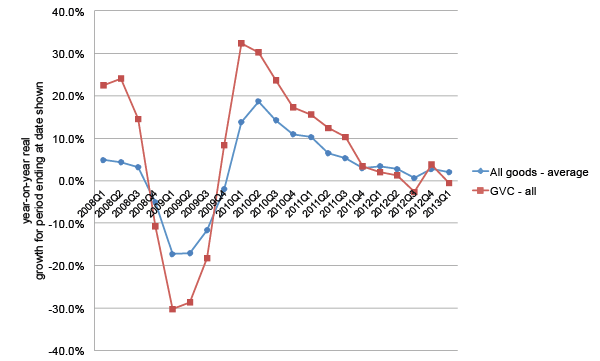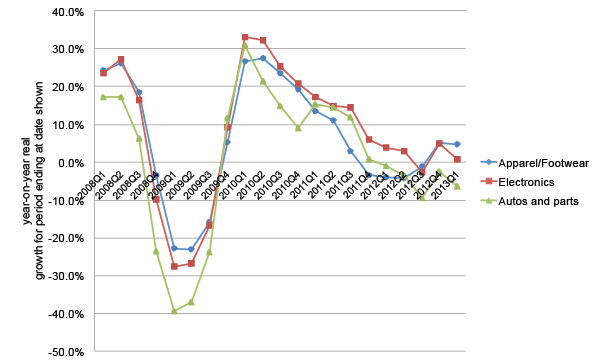Global value chains (GVCs) involve trade in goods that have multiple production stages that take place in many different countries (that is, ‘production fragmentation’ or ‘slicing up the value chain’), and in which multiple imports and exports of intermediate goods are necessary to produce a final good, which may also be exported. Since the emergence of the North American GVC in automobiles in the 1960s and the East Asian electronics GVC in the 1970s, the role of GVCs in international trade has become more important and has attracted increasing attention. There are several potential reasons why GVC trade may behave differently.1
The role of GVCs in international trade
- First, there is a crude statistical argument for a relationship between GVC trade and slowdowns, arising from the fact that there are more trade flows in GVC trade than in non-GVC trade.
If an exported good is produced entirely within the exporting country, and there is a reduction in demand, then one trade flow disappears. But if the exported good is produced with an imported input, there are two trade flows (the import of the input and the export of the final good), and thus the same drop in demand for the final good causes two trade flows to disappear. This simple argument turns out to be fallacious (O’Rourke 2009). Since there is twice as much trade in a GVC world, then a 1% drop in demand leads to a 1% drop in both intermediates and final trade, which is not unusual.
However, global trade, in fact, consists of both GVC trade, say, complex goods such as automobiles, whose parts and components are produced in different countries and then assembled in one location; and non-GVC trade, such as exports of bananas that require no further processing.
- If there is a drop in global demand, and demand for complex goods such as automobiles drops more rapidly than demand for simple goods like bananas, then a compositional effect of decelerating demand for goods produced in GVCs (for example, complex consumer goods and capital goods) could cause trade to slow down more rapidly than it would otherwise.
Since the world has gradually transitioned over the last several decades to a world in which GVC trade has become more important, there appears to have been a long-run increase in the elasticity of global trade with respect to global income (Escaith, Lindenberg, and Miroudot 2010). This increase in elasticity reversed itself in the late 2000s. Whether this reversal is due to cyclical factors associated with the recent financial crisis, or to the possibility that the structural transformation associated with the increasing geographical fragmentation of production is now nearly finished, is not yet known.
- In any case, the fact that demand for the final good is ultimately spread out over demand for intermediates in many countries means that the transmission of demand shocks during a slowdown in any one region may be more rapid and greater in a world where GVCs are important.
- In addition, different parts of a GVC may behave differently in a downturn. In particular, reductions in final demand may lead to even larger reductions in intermediate demand, so that trade in intermediates declines more rapidly than trade in final goods, the so-called bullwhip effect (Altomonte et al. 2012, Zavacka 2012).
When demand for final goods slows, exporters of such goods can continue for a while on inventory rather than ordering new intermediate goods for production, so intermediate goods trade declines more rapidly than final goods trade.
- On top of this, the effect of uncertainty is different in the upstream parts of the supply chain, especially for firms that are more peripheral in terms of decision making.
Having less information about the drop in demand for final goods, the suppliers of inputs may start avoiding risk, cutting production and trade in intermediate goods even more rapidly than if they had the same information as final-goods producers.
In a new World Bank Economic Premise Note (Ferrantino and Taglioni 2014), we show that, within these patterns, there is substantial regional and sectoral variation. While the above generalizations are useful, not every GVC produces a good whose final demand is unusually sensitive to declining income, and not every GVC exhibits bullwhip behaviour at all times. For example, GVCs in more sophisticated value chains, especially those associated with large multinational lead firms making extensive use of high-tech supply chain management tools, may be more adept at managing fluctuations in demand.
GVC trade in current slowdown
Figure 1 shows that in the current slowdown, trade in the three GVCs combined has declined more rapidly than global trade.2 In the Great Trade Collapse, the deceleration was also more rapid. However, during 2008–9, GVC trade collapsed more rapidly than global trade, and then boomed back. The current slowdown in GVC trade, relative to total trade, is more subtle. Arguably, GVC and non-GVC trade have grown at about the same rate since late 2011. However, in four of the last five rolling 12-month windows calculated on quarterly data, GVC trade has grown less rapidly than total trade. In the window of time ending in the first quarter of 2013, total global merchandise trade increased by 2.0%, while GVC trade declined by 0.6%.
Figure 1. Trade in global value chains has decelarated more rapidly than total trade
Source: Datastream, International Trade Commission (ITC), World Bank.
Figure 2. Motor vehicles and parts trade has led the decline in the current and previous slowdowns
Source: ITC, World Bank.
At the sector level, a decline in demand for motor vehicles and parts is leading the current slowdown, as it did during 2008–9. The bust-and-boom behaviour of trade in motor vehicles and parts has been associated with the domestic stimulus programs in this sector pursued by many countries in the aftermath of the 2008–9 recession (Figure 2). In turn, the phasing out of these programs may be contributing to the disproportionate slowdown in motor vehicle trade.
GVCs often operate on a regional basis to optimize time and transport costs. On a regional basis, the slowdown in EU27 demand is most notable. EU27 imports of GVC goods (including intraregional imports) did not recover as dramatically as imports of other regions, and have been in absolute decline in real terms since 2011. In the most recent 12-month window ending in the first quarter of 2013, real growth in NAFTA and East Asian GVCs is also negative, while GVC imports by the rest of the world have been more resilient.
Differences between intermediate and final goods trade
One difference between the current trade slowdown and the Great Trade Collapse is that the strong bullwhip behaviour (intermediate trade declining more than final goods trade) that characterized 2008–9 did not happen in the latest slowdown. Trade in intermediate and final GVC goods are currently decelerating at a proportional rate.
Given the hypothesized origin of bullwhip behaviour in the management of uncertainty and inventories, there are some potential explanations for this difference. It could be that firms in GVCs have learned from 2008–9 and are able to adjust production in the supply chain more efficiently and better anticipate the slowdown. Also, because the current slowdown is more modest, there is less uncertainty in the system overall for firms to react to, thus less bullwhip behaviour.
However, breaking down the behaviour of final versus intermediate trade by sector and region, it appears that bullwhip behaviour is not entirely extinct. Over the last two years, declines in intermediates trade in excess of final goods trade characterized the electronics GVC for most of 2011 and 2012, but have recently moderated. Intra-EU trade in GVCs as a whole has exhibited bullwhip behaviour. For the year ending in the first quarter of 2013, real intra-EU GVC trade in final goods increased by 1.3%, while intra-EU GVC trade in intermediates decreased by 5.4%.
GVCs’ impact on EU slowdown
Trade is likely to slow down most rapidly in countries exporting to regions where demand has slowed down the most. In recent years, the most notable slowdown in demand has been in Europe. While world economic activity grew by 4% in 2011 and 3.2% in 2012, with projections for 2013 at 3.3%, in the EU27 it only grew by 1.6% in 2011, and contracted by 0.2% in 2012. The slowdown in Europe is having significant spillover impacts on its trading partners, particularly on partners in Africa and the Middle East.
Ongoing financial market friction in the European Union, particularly in the Eurozone, have also greatly increased uncertainty, leading to delays on investment and expenditure decisions, especially regarding durable goods. Increases in uncertainty can have a dampening effect on trade, as producers scale back investment decisions and inventory accumulation (as discussed above under the bullwhip effect) and consumers postpone purchases. Evidence shows that, even taking traditional determinants of trade into account, exports to markets experiencing stock market volatility decline by more than expected (Taglioni and Zavacka 2012).
The deterioration of financing conditions in the European Union also poses a problem. Inadequate financing constrains working capital, which affects firms’ investment decisions and limits funds, particularly for small and medium enterprises, which are the backbone of the EU economy. The prolonged financial crisis in the European Union likely has had a significantly negative impact on firms, which in turn has affected the exports of their foreign suppliers.
Conclusion
The recent slowdown in global merchandise (2010-early 2013) confirms some of the lessons learned during the Great Recession. Trade in complex products organized in GVCs has once again been more sensitive to global downturns than has trade in simple products, particularly for motor vehicles. For motor vehicles, the start-and-stop nature of incentives in many countries may have added to the volatility. Conversely, trade in simpler products appears once again to be more resilient to global downturns. Although evidence is still accumulating, this suggests that the preference often expressed for countries to go ‘up the value chain’ by specializing in more and more complex products may need to be qualified. While diversification is one way to manage risk associated with export portfolios, focusing on simpler products less associated with GVCs may be another way, and there is likely to be a trade-off between these two strategies. Continued monitoring and research in this area is warranted.
Footnotes
1. Baldwin (2009) reviews the explanations for the Great Trade Collapse offered by economists in mid-2009, including the role of GVCs.
2. Due to lagged reporting of monthly figures at the product level, data for this analysis are only available through the first quarter of 2013. Nominal GVC trade has been deflated using sector-specific import price deflators for the United States, taken as a rough proxy for the global market.
References
Altomonte, Carlo, Filippo Di Mauro, Gianmarco Ottaviano, Armando Rungi, and Vincent Vicard (2012), “Global Value Chains During the Great Trade Collapse: A Bullwhip Effect?”, European Central Bank Working Paper 1412.
Baldwin, Richard, ed. (2009), The Great Trade Collapse: Causes, Consequences and Prospects, London: Center for Economic Policy Research and VoxEU.org.
Escaith, Hubert, Nannette Lindenberg, and Sébastien Miroudot (2010), “International Supply Chains and Trade Elasticity in Times of Global Crisis”, Economic Research and Statistics Division Staff Working Paper 2010-08, World Trade Organization, Geneva.
Ferrantino, M and D Taglioni (2014), “Global Value Chains in the Current Trade Slowdown”, World Bank, Economic Premise no. 137.
O’Rourke, Kevin (2009), “Collapsing Trade in a Barbie World”.
Sturgeon, Timothy J and Olga Memedovic (2011), “Mapping Global Value Chains: Intermediate Goods Trade and Structural Change in the World Economy”, United Nations Industrial Development Organization, Development Policy and Strategic Research Branch Working Paper 05/2010, Vienna.
Taglioni, Daria and Veronika Zavacka (2012), “Innocent Bystanders: How Foreign Uncertainty Shocks Harm Exporters”, World Bank Policy Research Working Paper WPS 6226, Washington, DC.
Zavacka, Veronika (2012), “The Bullwhip Effect and the Great Trade Collapse”, European Bank for Reconstruction and Development Working Paper 148.




